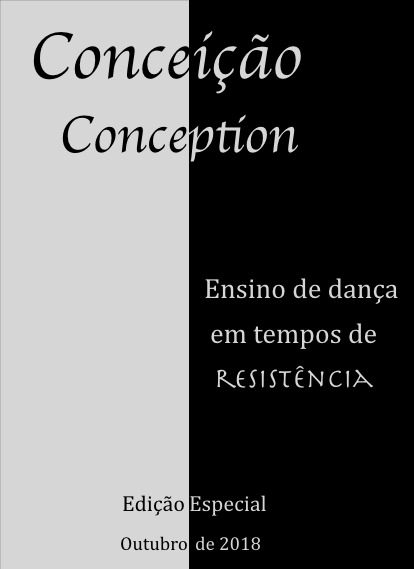Abstract
Here is a study on inclusive dance education focusing on two specific groups: the elderly and the visually impaired -with whom the researchers worked on their studies. This work is part of inclusive education, studying education for those who did not always have space in dance, due to deficiencies or physical restrictions arising from natural or acquired processes. With this, the aim is to broaden the possibilities of the professionals of dance teaching and to highlight the benefits of the training of the graduation in dance for those who work with such people, containing in this work ideas on how to work with this distinguished public. It also contains reflections on personal and collective transformations of the individuals involved in these processes.
References
ANDRAUS, M. B. M., FONSECA T. C. Propriocepção e consciência corporal para pessoas com deficiência visual. FAPESP Proc.2014/21807-2. Campinas, 2016.
BEAUVOIR, S. (1970). A Velhice. Trad. Maria Helena de Franco Martins. Editora Nova Fronteira (Rio de Janeiro). 1990.
BERTAZZO, I. A importância da dança na formação do cidadão (2003). Disponível em: https://culturaecurriculo.fde.sp.gov.br/Administracao/Anexos/Documentos/420100823115851A%20import%C3%A2ncia%20da%20dan%C3%A7a%20na%20forma%C3%A7%C3%A3o%20do%20cidad%C3%A3o.pdf Acesso em: 25/10/2018.
BRASIL. Dados sobre o envelhecimento no Brasil. Coordenação Geral dos Direitos do Idoso (Secretaria de Direitos Humanos). 2011. Disponível em http://www.sdh.gov.br/assuntos/pessoa-idosa/dados-estatisticos. Acesso em 03/11/2016.
CAZÉ, C. M. de J. O., OLIVEIRA, A. da S. Dança além da visão: possibilidades do corpo cego. Pensar a prática (Goiânia), v. 11, n. 3, 2008. Disponível em: http://www.revistas.ufg.br/index.php/fef/article/viewArticle/3592 Acesso em 10/9/2014.
FIGUEIREDO, V. M. C., TAVARES, M. da C. G. C. F., VENÂNCIO, S. Olhar para o corpo que dança: um sentido para a pessoa portadora de deficiência visual. Movimento (Porto Alegre), ano V, n. 11, 1999.
LIMA, M. D., JAEGER, A. A. Dançando a corporeidade da criança com Síndrome de Down. Santa Maria: Revista Kinesis. p.96-186. Nov. 2002.
NUNES, S. M. Fazer dança e fazer com dança: perspectivas estéticas para os corpos especiais que dançam. PONTO DE VISTA , Florianópolis, n. 6/7, p. 43-56, 2004/2005.
STUART, I. A Experiência do Judson Dance Theater. In: PEREIRA, R.; SOTER, S. (Org.). Lições de Dança 1. Rio de Janeiro: UniverCidade. 1997. pp. 191-203.
Trinity Laban Conservatoire of Music and Dance. Dance towards well-being in the Third Age. Commisioned by the London Thames Gateway Dance Partnership. Inglaterra: Londres. 2010. Disponível em: http://www.trinitylaban.ac.uk/news/latest-news/dancing-towards-wellbeing-third-age. Acesso em 17/11/2016.
VIEIRA, S. P. O Bem Estar Subjetivo em Nonagenários: um estudo qualitativo. Campinas. Dissertação de mestrado, Programa de Pós-Graduação em Gerontologia da Faculdade de Ciências Médicas/FCM-Unicamp, 2009.
VITTA, A. Atividade Física e Bem-Estar na Velhice. In: NERI, A. L.; Freire, S. A. (Org.). E por falar em boa velhice. Campinas - SP. Papirus. 2000. pp. 81-89.
Conceição / Conception uses the Creative Commons (CC) license, thus preserving the integrity of articles in an open access environment. The journal allows the author to retain publication rights without restrictions.

